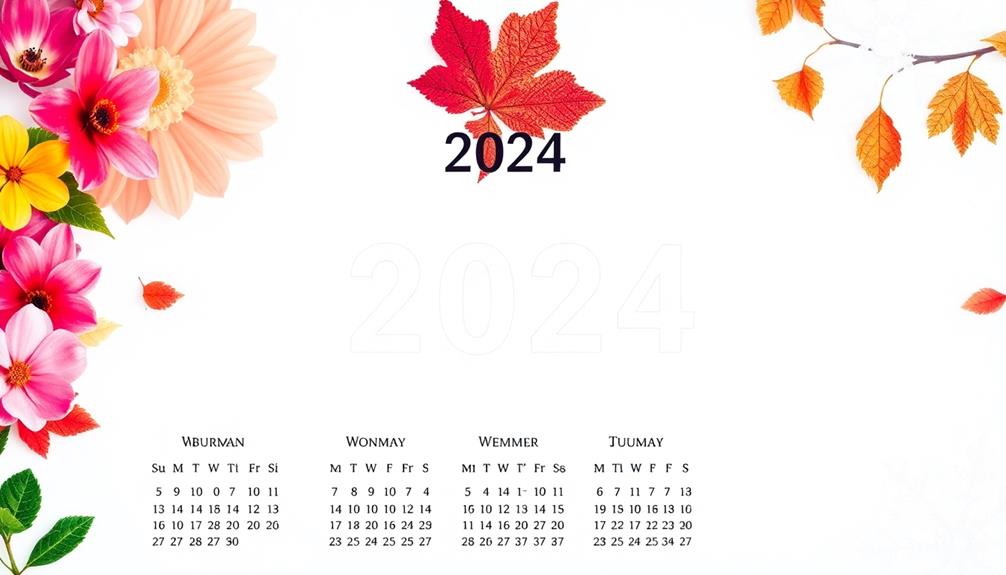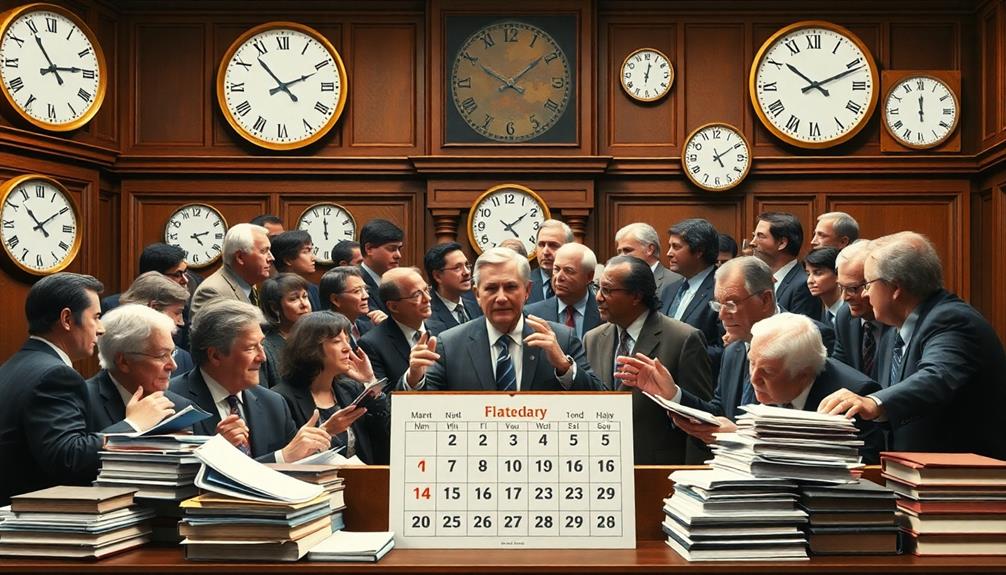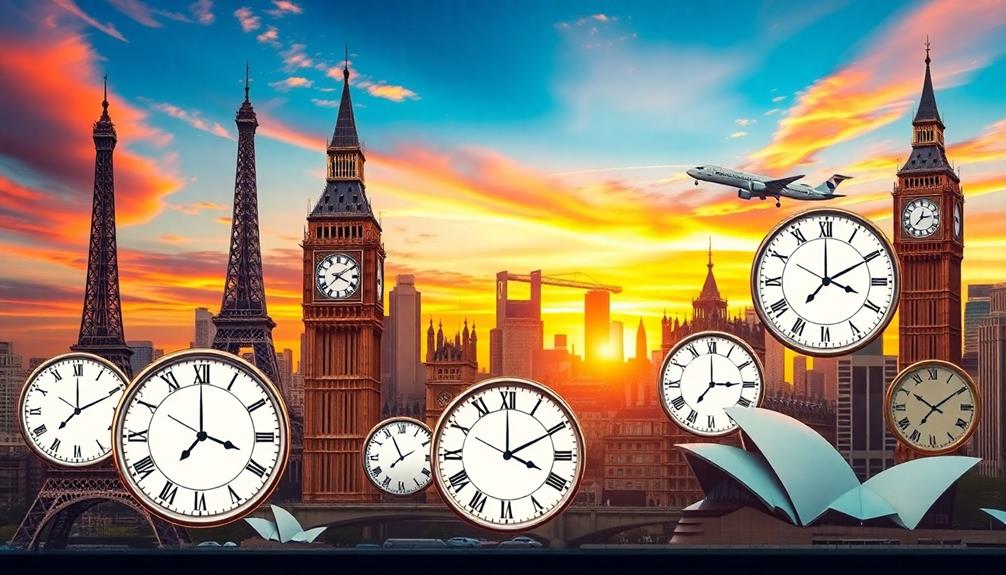The time changes on March 10, 2024, when you'll set your clocks forward one hour at 2:00 a.m., kicking off Daylight Saving Time. Then, on November 3, 2024, you'll fall back an hour at 2:00 a.m., returning to standard time. Most of the U.S. observes this schedule, but Hawaii and most of Arizona don't participate. These shifts aim to help you enjoy longer daylight during summer months. Want to know more about the impact of these time changes? There's plenty to uncover about Daylight Saving Time's history and effects on daily life!
Key Takeaways
- Clocks spring forward on March 10, 2024, at 2:00 a.m. local time for Daylight Saving Time.
- Daylight Saving Time ends on November 3, 2024, when clocks fall back at 2:00 a.m.
- Most of the U.S. observes DST, while Hawaii and most of Arizona do not.
- Public sentiment is mixed, with about 50% favoring permanent DST.
- Adjust your sleep schedule gradually to adapt to time changes effectively.
Understanding Daylight Saving Time

Daylight Saving Time (DST) is a practice that shifts the clock to make better use of daylight during the longer summer days. Each year, this means you'll spring forward one hour on the second Sunday in March and fall back one hour on the first Sunday in November.
This time change kicks off a period where you can enjoy extended daylight in the evenings, which can lead to reduced energy consumption.
Since the implementation of the Energy Policy Act of 2005, DST has been observed for about eight months each year. The goal is to decrease reliance on artificial lighting, ultimately saving energy.
While most of the U.S. participates in this practice, there are exceptions, such as Arizona (excluding the Navajo Nation) and Hawaii, along with territories like Puerto Rico and Guam.
Understanding how DST works helps you adapt to these time changes and maximize your use of natural daylight. Knowing when to adjust your clocks allows you to plan better and enjoy those longer summer evenings.
Key Dates for 2024

As you prepare for the upcoming shifts in time, it's important to mark your calendar for 2024's key dates.
Daylight saving time (DST) kicks off on March 10, when you'll need to set your clocks forward one hour at 2:00 a.m. local time. This means that on the night of March 9, you'll move from 2:00 a.m. to 3:00 a.m., losing an hour of sleep but gaining more daylight in the evenings.
DST continues until November 3, 2024, when you'll set your clocks back one hour at 2:00 a.m., reverting to 1:00 a.m. This change marks the end of longer daylight hours and the return to standard time.
Most of the United States observes these changes, following the schedule established by the Energy Policy Act of 2005.
However, keep in mind that Hawaii and most of Arizona don't participate in DST. By noting these key dates, you can better manage your time and adapt to the seasonal changes that daylight saving time brings.
Historical Background of DST

The origins of Daylight Saving Time (DST) date back to the innovative mind of Benjamin Franklin, who suggested it in 1784 as a way to conserve energy by maximizing daylight. However, it wasn't until World War I that Germany first implemented DST in 1916 to save fuel. The United States followed suit in 1918 under the Standard Time Act.
After initial adoption, farmers pushed back against DST, leading to its repeal in the U.S. post-World War I. Yet, President Franklin Roosevelt revived it during World War II. The Uniform Time Act of 1966 then standardized the start and end dates across the U.S., marking the second Sunday in March and the first Sunday in November as official time changes.
In 2005, the Energy Policy Act extended DST, making it last about 34 weeks each year, starting in 2007. This history highlights the evolving purpose of DST, shifting from energy conservation during wars to a broader approach aimed at maximizing daylight.
| Year | Event |
|---|---|
| 1784 | Benjamin Franklin proposes DST |
| 1916 | Germany first implements DST |
| 1966 | Uniform Time Act standardizes DST |
| 2005 | Energy Policy Act extends DST duration |
Exceptions to DST Observance

When it comes to Daylight Saving Time, not all states play by the same rules.
You might be surprised to learn that Hawaii and most of Arizona don't observe DST at all, while U.S. territories like Puerto Rico also skip it.
Geographic factors and historical opposition have shaped these exceptions, leading to a patchwork of timekeeping practices across the country.
States Not Observing DST
While most states in the U.S. adjust their clocks for daylight saving time (DST), a few choose not to participate. Arizona and Hawaii are the only states that don't observe DST, opting instead for consistent time throughout the year.
In Arizona, the exception applies only to the Navajo Nation, which does follow DST. This decision is rooted in geographical and climatic considerations, as well as a local preference against the disruptions caused by clock changes.
By not observing DST, these states avoid the confusion that often arises when scheduling travel or business across state lines. For example, if you're in Arizona and want to connect with someone in a state that observes DST, you'll need to keep track of the time difference, which can shift depending on the season.
Additionally, several U.S. territories, including Puerto Rico and Guam, also don't participate in DST. This creates a patchwork of timekeeping across the nation, emphasizing the unique approaches different regions take regarding daylight saving time.
If you're planning to travel or conduct business, being aware of these exceptions will help you stay on schedule.
Geographic Considerations
Understanding geographic considerations is essential for grasping why certain regions opt out of Daylight Saving Time (DST). For instance, Hawaii and most of Arizona, excluding the Navajo Nation, don't observe DST, sticking to standard time year-round. This decision often stems from their unique climates and lifestyles, making the shift unnecessary.
The Navajo Nation presents an interesting case, as it observes DST, leading to different timekeeping practices within the same state.
Additionally, U.S. territories like Puerto Rico, Guam, American Samoa, and the U.S. Virgin Islands also choose not to participate in DST. These geographic considerations reflect local preferences and cultural factors, which can complicate timekeeping for travelers and businesses crossing state lines.
In Canada, the situation is similar. While nine out of ten provinces observe DST, exceptions exist in parts of British Columbia, Saskatchewan, and northern Ontario.
These variations highlight the complexities surrounding time observance and remind you that not all regions share the same approach to daylight saving time. Understanding these geographic nuances can help you navigate time differences more effectively when planning your travels or business operations.
Historical Opposition Factors
Many people have historically opposed Daylight Saving Time (DST) for various reasons, leading to exceptions in its observance across different regions. Arizona and Hawaii stand out as the two U.S. states that don't follow DST, primarily due to geographic and climatic factors that lessen the need for extended evening daylight. Farmers have long been a vocal opposition group, arguing that DST favored urban office workers and disrupted agricultural schedules. This opposition played a significant role in the repeal of DST after World War I in 1920.
The table below summarizes some key exceptions and factors related to DST opposition:
| Region | Reason for Opposition | Current Status |
|---|---|---|
| Arizona | Geographic climate | Does not observe DST |
| Hawaii | Tropical climate | Does not observe DST |
| Navajo Nation | Mixed observance | Observes DST |
| Indiana (various) | Localized preferences | Some areas opt-out |
| Legislative Trends | Ongoing debates about relevance | Many states consider changes |
The persistence of opposition to DST is evident in ongoing legislative measures aimed at eliminating the biannual clock changes.
Economic Effects of DST

Daylight Saving Time (DST) has a significant impact on the economy, particularly for local businesses. With extended daylight hours, you'll notice that shoppers are more inclined to venture out in the evenings, driving increased sales. The U.S. Chamber of Commerce even praises this shift for enhancing commerce and evening shopping opportunities.
Here are some key economic effects of DST:
- Boost in Sales: Local businesses often report an economic boost during DST months due to heightened consumer activity.
- Recreational Growth: The golf industry alone saw a $200 million sales increase, showcasing how longer days can spur recreational spending.
- Seasonal Impact: Events like Halloween benefit, as extended daylight allows more time for trick-or-treating, further influencing candy sales.
While energy savings from DST may vary, the positive effects on local businesses are clear. The extra hour of daylight encourages you to spend more time and money outside, ultimately benefiting the economy.
It's not just about the clock changing; it's about creating vibrant, bustling communities during those longer evenings.
Public Sentiment on DST

Public sentiment on Daylight Saving Time (DST) is quite mixed, reflecting a nation divided on the issue. Approximately 50% of you favor permanent daylight saving time, while around 31% support keeping standard time year-round. This division showcases the ongoing debate about whether DST is beneficial or detrimental.
As of early 2023, 19 states have passed bills to end the clock-switching practice, but those measures can only take effect if federal law changes. A Senate bill proposing permanent DST in 2022 didn't advance in the House, indicating that public opinion remains unsettled.
Concerns about health impacts also play a significant role in the conversation. Many argue that the time changes disrupt sleep patterns and could lead to increased risks of heart attacks. Organizations like the American Academy of Sleep Medicine advocate for year-round standard time, emphasizing the negative effects of these clock shifts on public health.
As you navigate this debate, consider how the changing times affect not just your schedule but also your well-being. With strong opinions on both sides, the future of DST remains uncertain, and your voice could help shape it.
Legislative Changes and Proposals

As you look at recent legislative proposals, you'll notice a growing trend among states aiming to change how we handle daylight saving time.
Initiatives like Florida's Sunshine Protection Act show that many are pushing for year-round DST or to eliminate it altogether.
It's clear that state-level actions are reflecting a mix of public opinions on this time-altering practice.
Recent Legislative Proposals
Legislation surrounding time changes is rapidly evolving, with over 30 states introducing proposals to either abolish Daylight Saving Time (DST) or adopt it permanently. This shift reflects a growing public interest in reevaluating how we manage our time.
Some key developments include:
- Florida's Sunshine Protection Act, passed in 2018, seeks to implement year-round DST but still awaits federal approval.
- Washington and Georgia have also passed bills for permanent DST, contingent on federal legislation that would allow such changes.
- A 2022 Senate bill proposing permanent DST stalled in the House, underscoring the challenges in reaching a consensus.
Public sentiment remains divided. While 50% of Americans favor permanent DST, 31% advocate for maintaining standard time year-round.
These recent legislative proposals indicate that discussions around time changes are far from over. The debate over whether to adopt permanent standard time or keep switching between time formats continues, highlighting the complexity of managing time in our daily lives.
As these proposals evolve, it's crucial to stay informed and engaged in the conversation about our timekeeping practices.
State-Level Initiatives Overview
Across the United States, state-level initiatives are reshaping how time is observed, with numerous proposals aimed at either abolishing Daylight Saving Time (DST) or adopting it permanently.
In fact, over 30 states have introduced bills reflecting a growing public sentiment against the clock-switching practice. Many state legislatures are taking action, with Florida's Sunshine Protection Act, passed in 2018, seeking to establish year-round daylight saving time. However, it's still awaiting federal approval to take effect.
States like Washington and Georgia have also passed legislation for permanent DST, contingent on federal consent, signaling a significant trend toward changing how time is observed at the state level.
As of January 2023, 19 states had passed bills to abolish DST, but remember that any changes will require amendments to federal law to be implemented.
Public support for these initiatives is mixed; approximately 50% of people favor permanent DST, while 31% prefer maintaining standard time year-round.
This divide highlights the ongoing debate and the importance of understanding how your state's decisions may affect your daily life as these initiatives continue to evolve.
Health Impacts of Time Changes

The biannual clock changes can seriously impact your health, leading to a range of physical and mental challenges. When you spring forward or fall back, your circadian rhythm gets disrupted, which can affect your sleep patterns and overall well-being.
Studies show that after the spring forward change, you could lose an average of 40 minutes of sleep. This sleep deprivation is linked to several concerning health impacts:
- A 24% increase in heart attack incidents on the Monday following the spring shift.
- A 5.7% rise in workplace injuries during the days after the time change.
- Increased rates of depression and adverse mental health outcomes during adjustment periods.
Health experts, including the American Academy of Sleep Medicine, recommend sticking to year-round standard time to help mitigate these negative effects.
Adjusting to a new schedule isn't just a minor inconvenience; it can lead to serious health risks. By understanding these impacts, you can take proactive steps to manage your health around time changes.
Prioritizing your sleep and maintaining a consistent schedule can make a significant difference in how you feel during these shifts.
Global Practices and Variations

Countries around the world tackle the issue of time changes in different ways, leading to a patchwork of practices. Less than 40% of countries observe daylight saving time (DST), primarily those with significant seasonal daylight variation, such as many in Europe and parts of North America.
In Europe, DST typically kicks off on the last Sunday in March and wraps up on the last Sunday in October, with Central European Summer Time (CEST) and Eastern European Summer Time (EEST) in play during these months.
Australia also shows varied approaches; states like New South Wales and Victoria observe daylight saving time, while Queensland and the Northern Territory have opted out entirely. Public sentiment is shifting, as evidenced by a recent EU poll where 84% of respondents favored ending the clock changes associated with DST.
Interestingly, some countries, like Russia, Iceland, and Belarus, don't observe DST at all, creating significant differences in global practices.
This inconsistency can lead to confusion, especially for travelers and international businesses, highlighting the need for clear communication about local timekeeping practices.
Tips for Managing Time Changes

Managing time changes can be challenging, but with a few practical strategies, you can ease the adjustment. Start by gradually adjusting your sleep schedule by 15-30 minutes each day before the time change. This allows your body to adapt more easily and keeps your internal clock in check.
Additionally, being mindful of your mental health during this adjustment is important, as small mistakes in managing stress can lead to larger issues later on; consider incorporating daily mindfulness techniques to enhance your well-being.
Incorporate these tips to help you manage the adjustment:
- Get morning sunlight: Natural light exposure in the morning can help reset your internal clock and boost your alertness throughout the day.
- Stay hydrated and eat well: A balanced diet and proper hydration can counteract fatigue and mood swings that might come with the time change.
- Create a calming pre-sleep routine: If you struggle to sleep, consider establishing a calming routine to signal to your body that it's time to wind down.
Frequently Asked Questions
Is the US Getting Rid of Daylight Savings Time in 2024?
No, the U.S. isn't getting rid of daylight saving time in 2024. Despite some states pushing for change, federal approval is still needed, and the current schedule is set to continue as usual.
Are We Turning the Clocks Back This Fall?
You'll be thrilled to know that this fall, you're indeed turning the clocks back! On November 3, 2024, at 2:00 a.m., you'll gain an hour and enjoy brighter mornings ahead.
What Time Will the Clock Turn Back?
The clock turns back at 2:00 a.m. on November 3, 2024. You'll set it to 1:00 a.m., gaining an extra hour of sleep and enjoying brighter mornings as winter approaches.
Did We Lose an Hour of Sleep or Gain?
Oh sure, you just "gained" an hour of sleep by setting your clock back, but who really believes that? In reality, you lost an hour, and your sleep cycle's now in utter chaos!
Conclusion
As you adjust to the time changes, remember that about 70 countries observe Daylight Saving Time, affecting billions of people worldwide. Surprisingly, studies show that the shift can lead to a 25% increase in heart attack risk in the week following the change. By understanding the implications of DST, you can better manage your routine and health. So, whether you love the extra hour of daylight or not, staying informed helps you navigate this twice-a-year adjustment smoothly.










